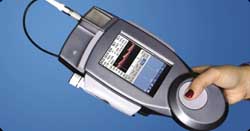2008-02-27
SABIC Innovative Plastics helps multigon design cost-effective transcranial doppler device to detect brain injuries

A new portable Transcranial Doppler (TCD) device from Multigon Industries, Inc., featuring SABIC Innovative Plastics’ LNP™ Faradex™ compound, provides a new way to detect unseen, yet traumatic, brain injuries in the field – whether a football field or a battlefield. The Neurovision™ 500P pocket TCD, with electromagnetic/radio frequency interference (EMI/RFI) shielding provided by LNP Faradex compound, makes it easier for doctors and other medical personnel to evaluate a potential brain injury on site, possibly improving outcomes from head injuries through early diagnosis and intervention.
Before the use of TCD technology, assessing a possible brain injury in the field was an inexact process: ask questions; check speech patterns; look for dilated pupils. However, lacking these clues and access to a CT scan, an injured athlete or soldier might be sent back into action instead of receiving treatment. To meet the need for a highly precise yet highly portable diagnostic tool, Multigon developed the handheld Neurovision 500P device. The company sought a solution for the housing that would offer shielding yet help keep costs down to spur wide adoption and minimize weight for maximum portability.
The Neurovision TCD requires EMI/RFI shielding to prevent interference that could impair its performance. Multigon turned to SABIC to find a cost-effective and lightweight shielding solution for the housing. Traditional plastic using a copper overspray is expensive, labor-intensive, and may result in uneven application that can affect performance. SABIC supplied LNP Faradex DS 1003 FR HI composite, a polycarbonate-based material infused with stainless steel fibers. By avoiding the secondary metal-spraying operation, LNP Faradex compound reduced manufacturing costs while delivering equivalent or better shielding performance.
“SABIC reaffirms our dedication to helping the healthcare industry achieve diagnostic and clinical breakthroughs,” said Clare Frissora, market director for Healthcare, SABIC. “By leveraging our global resources, material technologies and strong customer relationships, such as the one with Multigon Industries, we are supporting the industry’s efforts to improve quality of care.”
Improved Performance, Cut Shielding Costs in Half
“We initially used a copper overspray to provide shielding for the Neurovision housing,” said William Stern, vice president, Multigon Industries. “However, the time and labor associated with spraying added a significant amount to the cost of producing the housing. We also were concerned about inconsistencies in the application that could impact performance. By working with SABIC, we found a much better solution that not only cut our costs by 60 percent, but also provides uniform shielding performance. LNP Faradex compound helps us keep costs down to drive adoption of the Neurovision 500P.”
The Neurovision 500P pocket TCD system opens up new possibilities for TCD exams and patient care. Its small size, portability, and full feature set, as well as low cost, make it a perfect diagnostic tool for any setting. Intuitive and convenient one-handed operation helps clinicians conduct exams accurately and efficiently. Completed studies are stored on removable flash cards and transferred to a personal computer for post-processing and patient report generation. By using a complete range of Doppler probes, the Neurovision 500P can be used for transcranial, carotid, and peripheral Doppler analysis.
LNP Faradex DS 1003 FR HI compound leverages stainless steel fibers to provide enhanced shielding performance without the need for secondary metal-coating operations. Shielding effectiveness is 40–55 db (@0.125in.). It also provides flame retardance that supports requirements for elimination of halogenated additives, as well as high impact resistance performance and low shrinkage.
Information about the company: Saudi Innovative Plastics Sweden AB